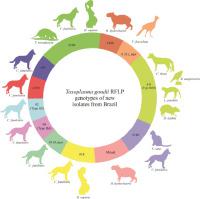Acta Tropica ( IF 2.7 ) Pub Date : 2020-09-11 , DOI: 10.1016/j.actatropica.2020.105681 Rute Witter 1 , Hilda Fátima Jesus Pena 2 , Maerle Oliveira Maia 3 , Aline Oliveira de Magalhães 4 , Thaís Oliveira Morgado 3 , Edson Moleta Colodel 3 , Daniela Araujo Barros 5 , Michelle Igarashi 5 , Solange Maria Gennari 6 , Richard Campos Pacheco 3

|
We aimed to describe the genetic diversity of Toxoplasma gondii strains isolated from domestic animals, wildlife and humans in the Midwestern Brazil. For this purpose, fragments of tissue samples (heart, brain and lung) from 35 dogs, four cats, 105 wildlife, and amniotic fluids from eight pregnant women were collected and submitted to mouse bioassay test. In a total, 22 isolates from nine dogs, one cat, ten wild animals and two women were obtained. The DNA was extracted from T. gondii isolates (lungs and brains of infected mice) and from “primary samples” (aliquots of tissue homogenate from wild animals and amniotic fluids from pregnant women) in order to screen using a Polymerase Chain Reaction (PCR) targeting a repeated 529-base pairs fragment of the T. gondii genome. All positive PCR samples were genotyped using restriction fragment length polymorphism (RFLP) analysis. To the best of our knowledge, this was the first study to report isolates of T. gondii from Leopardus pardalis, Crax fasciolata, and Dasyprocta azarae. Moreover, multilocus PCR-RFLP revealed 11 T. gondii RFLP genotypes, comprising nine previously described, including the archetypal lineage #2 type III (n = 1); two clonal Brazilian lineages, #6 type BrI (n = 1) and #8 type BrIII (n = 5); #14 (n = 2), #41 (n = 1), #108 (n = 1), #140 (n = 2), #166 (n = 4), #190 (n = 1), one potentially mixed, and two new described genotypes in two isolates. Our results confirmed the high diversity of T. gondii strains in Brazil, including identical genotypes circulating among humans, domestic dogs and wildlife.
中文翻译:

巴西中西部弓形虫的分离和基因分型显示出高度的遗传多样性和新的基因型。
我们旨在描述从巴西中西部的家畜,野生动植物和人类中分离到的弓形虫菌株的遗传多样性。为此,收集了来自35只狗,四只猫,105种野生动物和八名孕妇的羊水的组织样本(心脏,大脑和肺)的片段,并进行了小鼠生物测定测试。总共从9只狗,1只猫,10只野生动物和2名妇女中分离出22种分离株。该DNA提取自弓形虫分离株(受感染小鼠的肺和脑)和“原始样品”(来自野生动物的组织匀浆的等分试样,以及来自孕妇的羊水),以便使用聚合酶链反应(PCR)进行筛选靶向弓形虫的一个重复的529个碱基对的片段基因组。使用限制性片段长度多态性(RFLP)分析对所有阳性PCR样品进行基因分型。据我们所知,这是第一个报道来自豹纹豹,Crax fasciolata和Dasyprocta azarae的弓形虫分离株的研究。此外,多位点PCR-RFLP揭示了11个刚地弓形虫RFLP基因型,包括先前描述的9种,包括原型谱系#2 III型(n = 1);两个 巴西克隆谱系,#6型BrI(n = 1)和#8型BrIII(n = 5);#14(n = 2),#41(n = 1),#108(n = 1),#140(n = 2),#166(n = 4),#190(n = 1),一个可能混合的基因,以及两个分离物中的两个新描述的基因型。我们的结果证实了巴西弓形虫菌株的高度多样性,包括在人,家犬和野生动物之间传播的相同基因型。

























 京公网安备 11010802027423号
京公网安备 11010802027423号